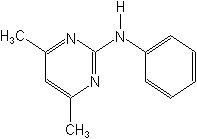-
Common NamePyrimethanil
-
中文通用名嘧霉胺
-
IUPACN-(4,6-dimethylpyrimidin-2-yl)aniline
-
CAS4,6-dimethyl-N-phenyl-2-pyrimidinamine
-
CAS No.53112-28-0
-
Molecular FormulaC12H13N3
-
Molecular Structure
-
Category
-
ActivityFungicide.
Pyrimethanil acts by preventing pathogenesis and is fungistatic. The compound is translocated acropetally in plants and has translaminar and vapour activity. Pyrimethanil has protectant activity against all species of Botrytis and up to 7 days preventive activity against Venturia. It has a curative activity against Venturia inaequalis which lasts for 72 hours after infection. The product is rainfast when dry.
Pyrimethanil has shown no cross-resistance to established botryticides or Venturia fungicides, and is recommended for use in a resistance management programme. This includes using the product in a programme with other fungicides of different modes of action and limiting the frequency of application. The product is safe to beneficial insects under normal use conditions. Pyrimethanil has been shown to improve wine quality by reducing the amount of the enzyme, laccase, produced by Botrytis. -
CropUse
Crop uses:
almonds, apples, beans, bulb vegetables, carrots, citrus, corm vegetables, cucumbers, lettuce, onions, oranges, ornamentals, pears, pome fruit, potatoes, stone fruits, strawberries, tomatoes, tree nuts, tuberous vegetables, vegetables, vines
Vines: 750-1, 000 g ai/ha
Strawberries: 800-1,000 g ai/ha
Peas: 600-800 g ai/ha
Apples: 20-30 g ai/hl
Tomatoes: 60-80 g ai/hl
Beans: 600 g/ha
-
PremixPyrimethanil+Fludioxonil
Pyrimethanil+Boscalid
Chlorothalonil+pyrimethanil
Soluble concentrate. Premix Parters: cypermethrin; beta-cypermethrin; thiometon.Type
AI concn
Suspension concentrate (SC)
30% (w/v) 40% (w/v)
-
Physical PropertiesMolecular weight:199.3. Physical form: Colourless crystals. Density:1.15 (20 °C); Melting point:96.3 °C; Vapour pressure:2.2 mPa (25 °C) ( OECD 104); Henry constant:3.6×10-3 Pa m3 mol-1 ( calc.); Partition coefficient(n-octanol and water):logP = 2.84 ( pH 6.1, 25 °C); pKa:3.52, weak base (20 °C) ( OECD 112); Solubility:In water 0.121 g/l ( pH 6.1, 25 °C). In acetone 389, ethyl acetate 617, methanol 176, methylene chloride 1000, n-hexane 23.7, toluene 412 (all in g/l, 20 °C).; Stability: Stable in water within the relevant pH range. Stable for 14 d at 54 °C. Solubility at 20°C: acetone 389 g/l, ethyl acetate 617 g/l, methanol 176 g/l, methylene chloride 1000 g/l, n-hexane 23.7 g/l, toluene 412 g/l.
-
ToxicologyOral:Acute oral
LD50 for rats 4150-5971 mg/kg, mice 4665-5359 mg/kg. Percutaneous:Acute percutaneous LD50 for rats >5000 mg/kg. Non-irritating to skin and eyes (rabbits), and not a skin sensitiser (guinea pigs). Inhalation: 50 (4 h) for rats >>1.98 mg/l. Phytotoxicity:May be phytotoxic in closed systems at 80% r.h. on certain species. ADI:0.1 mg/kg. -
Environmental ProfileEcotoxicology:
Algae:EbC50 (96 h) 1.2 mg/l.Bees: LD50 (oral and contact) >100 μg/bee.Birds:Acute oral LD50 for mallard ducks and bobwhite quail >2000 mg/kg. LC50 (5 d) for mallard ducks and bobwhite quail >5200 mg/kg diet.Daphnia: LC50 (48 h) 2.9 mg/l.Fish: LC50 (96 h) for mirror carp 35.4, rainbow trout 10.6 mg/l.Worms: LC50 (14 d) for earthworms 625 mg/kg dry soil.Other beneficial spp.:Classified as harmless to a range of beneficials.
Environmental fate:
Animals:Rapidly absorbed, extensively metabolised and rapidly excreted in all species examined. No evidence of accumulation, even on repeated dosing. Metabolism proceeds by oxidation to phenolic derivatives which are excreted as glucuronide or sulfate conjugates.Soil:DT50 in laboratory studies 27-82 d; field studies indicate rapid degradation, DT50 7-54 d. Koc 265-751. Low potential for leaching to groundwater; field studies show minimalPlant:Little metabolism occurs in fruit; residues at maturity consist essentially of unchanged parent compound only. For this reason, a crop residue monitoring method has been developed for the direct determination of pyrimethanil itself.
Mallard duck
LD50 >2,000 mg/kg Bobwhite quail LD50 >2,000 mg/kg
Rainbow trout [96 h]
LC50 10.56 mg/L Mirror carp [96 h] LC50 35.36 mg/L
Earthworm [14 d]
LC50 625 mg/kg Bee [contact] LD50 >200 μg/bee
Fate in :
Fate in soil:
Pyrimethanil is moderately adsorbed to soils and has a low leaching potential. Field studies have indicated minimal movement of the product into deeper soil layers.Fate in aquatic systems:
Pyrimethanil is degraded in water and has a half-life of between 6 and 11 days.
The Drinking Water Estimate Concentration (DWEC) of pyrimethanil was estimated using models generated using computer modelling (FIRST and SCI-GROW programmes). For surface water, the DWEC was calculated to be 122 ppb in the acute scenario and 37 ppb for the chronic. As the drinking water levels of concern for adults are 10,146 ppb and 5,944 ppb for the acute and chronic scenario, respectively, it appears that exposure to pyrimethanil in drinking water should not pose a risk to human health. -
Transport InformationHazard Class:III (Slightly hazardous)
Porduct NewsMore
Bayer launches fungicide Luna Tranquility in Chile
BASF launches new fungicide Vision Plus for Spanish market
Related CompaniesMore
Shandong Jingbo Agrochemicals Technology Co., Ltd.
Country: China
Pyrimethanil Pyraclostrobin Fomesafen Tebufenozide Fenoxanil Azoxystrobin Kresoxim-methyl Boscalid Nicosulfuron Emamectin benzoate Indoxacarb Quizalofop-P-ethyl
Country: China
Propineb Mancozeb Cymoxanil Propineb Fosetyl-aluminium Difenoconazole Azoxystrobin Mesotrione Thiacloprid Chlorothalonil
Jiangsu Weunite Fine Chemical Co., Ltd.
Country: China
Nitenpyram Azoxystrobin Chlorothalonil Acetamiprid Imidaclorprid Bentazone Carbendazim Chlorfenapyr Chlorthal-dimethyl Metaldehyde
Jiangsu Good Harvest-Weien Agrochemical Co., Ltd.
Country: China
Glyphosate S-metolachlor Metaldehyde Metamitron Penoxsulam Florasulam Mesotrione Amicarbazone Pyraclostrobin Mesosulfuron-methyl
Country: China
Glufosinate-ammonium 2,4-D MCPA Dicamba Propanil Clethodim Glyphosate Captan Flumioxazin Sulfentrazone

 0
0 Subscribe
Subscribe
